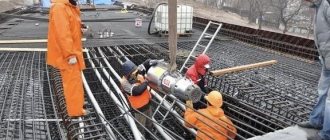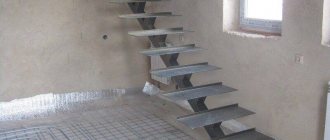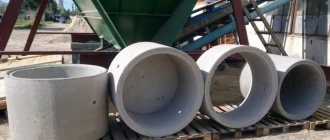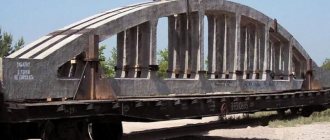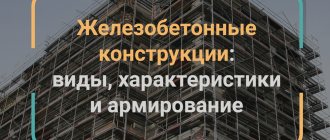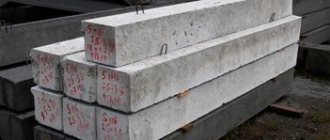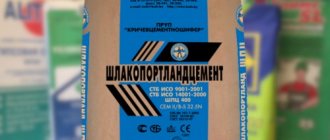When constructing buildings in the industrial sector, housing and communal services, and social infrastructure, precast reinforced concrete is used. This type of building material in its internal structure and technical and operational indicators does not differ from poured monolithic structures. The only difference is the method of manufacturing the products - prefabricated ones are manufactured on an industrial basis in a factory, and cast ones are manufactured on a construction site.
Features of concrete products
The use of reinforced concrete structures today is relevant in all areas of construction Source 1beton.info
The word “reinforced concrete” today has become a common noun, and when it is pronounced, it does not always mean a building material, but this certainly implies a definition of some kind of strength and inviolability. And in fact, if we take into account the qualities that monolithic and prefabricated reinforced concrete structures have, such a comparison is not without meaning.
Concrete reinforcement
Reinforcement of concrete allows you to strengthen its structure and make it more resistant to heavy loads Source vseoarmature.ru
The creation of any structures made of reinforced concrete involves reinforcement with steel rods of one or another section, which is already mentioned in the definition of the building material itself. For this purpose, steel wire with a cross-section of 6 mm is used, but this is most often used as an auxiliary element for the overall frame. Basically, reinforcement of monolithic, prefabricated and monolithic-prefabricated structures is made with steel rods with a diameter of 10 to 16 mm. In this case, different reinforcement is used, that is, it can be either smooth or corrugated (AIII).
For monolithic and prefabricated structures, reinforcing frames are connected using binding wire Source dom-s-ymom.org
Prestressed concrete
A characteristic feature of bendable reinforced concrete elements is the formation of cracks in the concrete of the tensile zone even under normal operating conditions, due to the low tensile strength of concrete (relative limiting strain εb-prev = 0.0001).
Let's consider a reinforced concrete beam with reinforcement from St. 3. When the stress in tensile reinforcement is δ = 1000 kg/cm2, i.e. within the limits allowed for Art. 3 during normal operation, the elongation of reinforcement in a section 1 m long will be equal to
At the same time, the maximum possible elongation of concrete
The insufficient tensile strength of concrete is compensated by the formation of cracks and the total opening width of cracks over a length of 1 m is 0.5-0.1=0.4 mm. However, with a large number of cracks, the width of each of them is so small that their presence does not interfere with the normal operation of the structure.
With metal savings in mind, we will increase the grade of steel by adopting Art. 5 at σ = 2000 ku/cm2. Moreover, at a length of 1 m
With the same value of ΔLb.prev, the total crack opening width over a length of 1 m is equal to 1.0–0.1 = 0.9 mm, i.e., it has increased by more than 2 times. Due to the uneven opening of cracks, some of them can become so wide that this will make the normal operation of the structure unacceptable (although even such cracks in the non-working concrete of the stretched zone have virtually no effect on the load-bearing capacity of the beam as a whole).
With reinforcement made of steel of the same grade St. 5, but of a periodic profile, reliable adhesion of concrete to reinforcement along its entire length will be ensured, stretched concrete will better follow the deformations of the reinforcement and with the same total opening width of cracks, their number will be greater, and the maximum opening width will be smaller (approximately as with reinforcement made of Art. 3).
However, further increasing the grade of reinforcing steel due to greater crack opening is practically impossible.
Prestressing of reinforced concrete provides the possibility of a further and very large increase in stress in the reinforcing steel, up to the use of high-strength wire with a tensile strength of up to 20,000 kg/cm2.
Scheme for saving prestressed concrete
The idea of prestressing is to preliminarily, i.e., before loading the beam with an operational load, to create compressive stresses in the zone of the beam that is in tension during operation. Then, when the beam is loaded with an operational load, tensile stresses in the concrete will appear only after the preliminary compressive stresses have been extinguished. And since the magnitude of the pre-compression force is widely adjustable, the beam can even be designed and constructed in such a way that there will be no tensile stresses in the concrete or under service loads.
Prestressing of reinforced concrete structures is carried out in two ways:
- tensioning the reinforcement on the stops and
- tension on concrete.
When tensioning on stops, the reinforcement, before laying the concrete mixture, is tensioned with hydraulic jacks to a certain tension not exceeding the elastic limit, and is secured at the ends in the stops. After this, the concrete mixture is laid and the reinforcement remains tensioned throughout the entire time the concrete hardens. After the concrete has hardened, the ends of the reinforcement are released and it, trying to return to its original length, compresses the concrete.
For rod reinforcement made of hot-rolled steel of periodic profile, an electrothermal version of this method is used, which differs from that described above in that the necessary elongation of the rods is achieved without the help of jacks by heating them by passing an electric current. The heated rods are fixed in stops, and when cooled they receive the necessary tension.
In concrete tensioning, the reinforcement is tensioned after the concrete has cured. To do this, during the manufacture of the structure, channels are left in it. After the concrete has hardened, rods of hot-rolled reinforcement or strands of high-strength wire are inserted into the channels and pulled with a jack, transferring reaction forces directly to the concrete of the structure itself, which creates compression of the concrete. Upon reaching the required force, the reinforcement is fixed in an extended state, the jacks are turned off, and the preliminary compression achieved when tensioning the reinforcement is maintained in the concrete. The channel is then filled (under pressure) with cement mortar.
Types of reinforced concrete structures
The type of reinforced concrete structures means their type of manufacture, and they are:
- monolithic or consisting of one solid block;
- prefabricated, which are manufactured at reinforced concrete products, transported to the construction site for assembly;
- prefabricated monolithic structures imply two types at once and are laid on site as a single whole.
Monolithic structures
Monolithic reinforced concrete is actively used in the construction of high-rise buildings, as well as private and industrial structures Source znaybeton.ru
Today, monolithic reinforced concrete structures are becoming more and more popular as a reliable, efficient and inexpensive type of construction. It is used in residential, industrial and even military applications. The process of creating monolithic reinforced concrete is quite simple. If this is a large industrial construction of any buildings or structures, then first the reinforcing frame is assembled, then the formwork is installed, into which a concrete mixture of one or another strength class and grade is supplied with a hose (depending on production calculations).
Strip foundation is ideal for private construction Source betonzone.com
At home (in the private sector), monolithic structures made of reinforced concrete are widespread strip foundations for the construction of houses, outbuildings and fences. In this case, the reinforcing frame is knitted in the form of a rectangular cube, lowered into a pre-dug trench and filled with concrete. Concrete is most often made on a construction site in a concrete mixer, but sometimes (if possible), an order is placed at a private or public enterprise and the solution is delivered in a ready-made concrete mixer. If there is a need, then formwork is installed over the trench, as in the top photo, and the strip foundation is poured simultaneously with the base.
Advantages and disadvantages
A reinforced concrete wall is a strong and durable structure that can withstand considerable loads and demonstrate positive properties and characteristics. Before implementing the project, it is necessary to carefully study all the features of this type of structure.
The main advantages of monolithic reinforced concrete walls:
- Light weight - 1 square meter weighs about 340 kilograms, which allows you to choose a lightweight foundation (for example, a square meter of brickwork weighs up to 960 kilograms)
- Long service life - monolithic reinforced concrete is not afraid of external negative factors, it lasts at least 100 years
- Strength and reliability due to the absence of joints in the structure and the risk of seams diverging and cracks appearing
- High level of fire safety, resistance to hurricanes, cyclones, seismic activity
- Savings on finishing materials and work thanks to even and smooth walls, allowing you to choose any interior option and not waste effort, time and money on leveling walls, eliminating defects, etc.
- The ability to perform all the work independently, without special vehicles and lifts
- Resistance to oxidation, corrosion
- Simplicity and high speed of installation
- Low cost of project implementation
- The ability to recreate the most original design idea - a reinforced concrete wall slab can be of any size; you can fill in a structure of any configuration, with curved, arched elements, implementing an original design for a cottage or designer's house
- Good thermal insulation characteristics due to the absence of cold bridges
The main disadvantages of a monolithic reinforced concrete wall:
- It is necessary to carry out heat/sound insulation measures
- Difficult to disassemble
- The risk of detachments, cracks and other deformations in the event of improper mixing of concrete, non-compliance with pouring technology, maintenance, etc.
- During construction in cold weather, it becomes necessary to warm up the concrete.
- The importance of additional care during the period of concrete strengthening and stopping work during this period
In general, a monolithic reinforced concrete slab demonstrates many more advantages than disadvantages. Moreover, many shortcomings can be leveled out by one or another solution, while the rest are more related to a number of features than obvious and serious disadvantages.
Reinforced concrete products
For prefabricated reinforced concrete structures, a number of products are used, which are manufactured on steam reinforced concrete products by vibration. Of course, it is impossible to do this at home, since technical conditions will not allow it (the basic lack of necessary equipment). The only thing that can at least somehow resemble a factory-made reinforced concrete product is something that can be done at home on an improvised vibrating table. But in this case, due to the inability to use steam, the product will have a drawdown, since water releases volume during evaporation.
Reinforced concrete slabs
Floors are transported flat with spacers made of wooden slats Source mskukraine.com
Reinforced concrete floor slabs in modern construction can be called the most popular material, since they are used to make not only ceilings, but also floors, or one floor performs a double function. This filling has a hollow structure, where the internal holes not only significantly reduce the weight of the product (almost half), but can also serve as cable channels for laying various communications. As a rule, this is wiring for ceiling (upper) lighting, but sometimes it can be alarm, TV or Internet cables.
